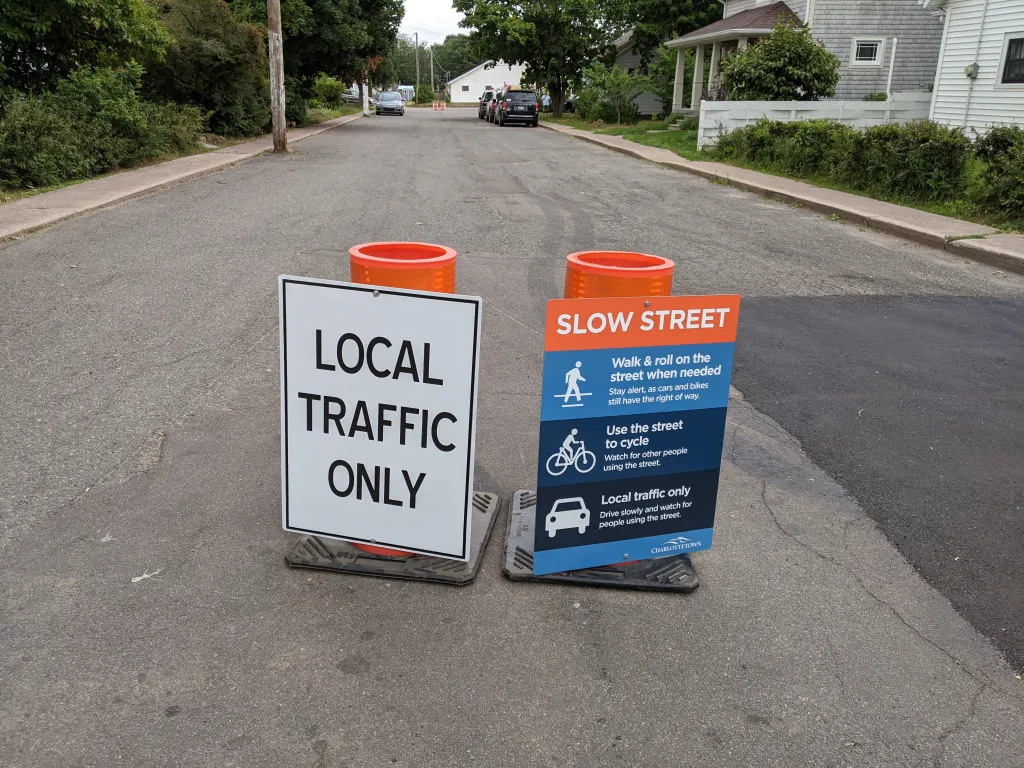It isn’t ”downtown as an active transportation first district” that I called for in April, but it ain’t nothing either: Charlottetown Launching Slow Streets Initiative.
The City of Charlottetown is launching a Slow Streets Initiative to help encourage active transportation throughout the City. Gay Avenue is the first road featured in the initiative with W. Burns Street being added by Friday, August 21.
The designated Slow Streets will allow more space for pedestrians and cyclists by featuring signage and barrels to notify motorists using the road to slow down and be mindful of pedestrians and cyclists that may also be using the roadway.
Traffic in this area will be monitored and, although it is not mandatory, it is strongly recommended that only local traffic use these streets. Local traffic is limited to any residents who live in the area, those visiting residents in the area, or anyone wishing to access businesses in the vicinity. Local traffic does not include motorists just wishing to travel through the street.
The Slow Streets Initiative is a pilot project which will end in October, when a review will be completed by City staff to determine the effectiveness of the project.
Kudos to the residents of Gay Avenue for holding themselves up as a test case, to Bike Friendly Charlottetown for bringing the idea forward to the Mayor’s Task Force on Active Transportation, and to City Council for coming together to make this happen.
(Photo by Steven Garrity, area resident)

 I am
I am
Comments
"Steven Garrity, area
"Steven Garrity, area resident" is actually what my kids call me.
excellent!
excellent!
This initiative is
This initiative is interesting but I wonder why did the City pick such a quiet street far away from the downtown core South of Euston? This lacks credibility, really does. I see this as another Mickey Mouse initiative going no where fast. Same as other projects the City started over the years and died quietly.
The initiative arose from a
The initiative arose from a request from a resident of the neighbourhood who canvassed the residents of Gay Ave., established a consensus, and brought the idea forward to Bike Friendly Charlottetown, which brought the idea to City Hall. The project neither lacks credibility nor is it Mickey Mouse: it was grassroots advocacy working exactly as it should.
Putting up walls is a first
Putting up walls is a first step towards a ghetto.
"ghet·to ghet·to
/ˈɡedō/
noun: ghetto; plural noun: ghettoes; plural noun: ghettos
- a part of a city, especially a slum area, occupied by a minority group or groups.
verb: ghetto; 3rd person present: ghettoes; past tense: ghettoed; past participle: ghettoed; gerund or present participle: ghettoing
- put in or restrict to an isolated or segregated area
That’s certainly something I
That’s certainly something I’ve thought a lot about: while I believe in this instance the aim is true, I can imagine the same tool being used by residents elsewhere to create a de facto gated community. One person’s “slow down, give preference to people not in cars “ is another person’s “stay out of our neighbourhood.”
Peter by your comment I take
Peter by your comment I take it that you knew more about this local resident project than what you said in your post. My comment was directed not at the resident but at City Council who for the last 5 years has had many projects being announced and then dropped without any notice. This is a good project and I am suggesting that maybe a dozen streets all over the city including the old 500 Lot should have been included to make it more representative and get a better sample. Traffic is a problem and lots of it is not needed.
Add new comment